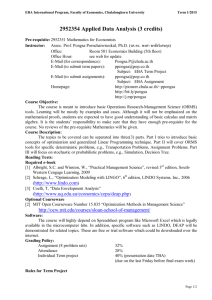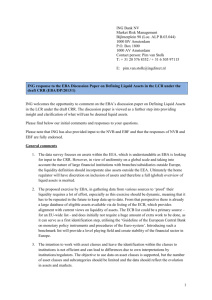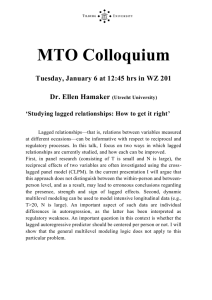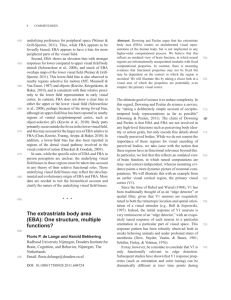Stock Market Anomalies and Model Uncertainty
advertisement
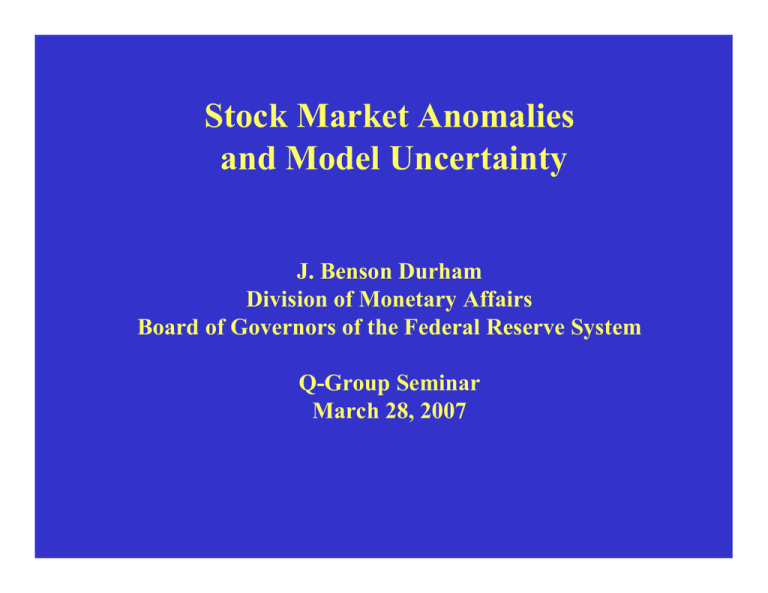
Stock Market Anomalies and Model Uncertainty J. Benson Durham Division of Monetary Affairs Board of Governors of the Federal Reserve System Q-Group Seminar March 28, 2007 Outline 1. Model uncertainty and Extreme Bound Analysis (EBA) 2. The mechanics of EBA 3. Application to stock market anomalies 4. Rejoinders, improvements, and alternatives to EBA 5. Is model uncertainty practitioners’ biggest worry? The Motivation for EBA 1. Karl Popper and The Logic of Scientific Discovery: How does one “paradigm” replace another? 2. Is this just “common sense?” 3. Truly controlled experiments are rarely feasible. 4. We must resort to econometrics. The Mechanics of EBA • Increase the information set as much as possible – given a set of possible factors, χ, run M models following Y = αj + βzjz + βfjf + βxjxj + ε where Y is the dependent variable. z is a “doubtful” variable of interest in χ. f is the set of “free” variables. x is an n-factor subset of χ. Decision Rules A. Given M estimates of βzj and σzj,the “traditional” rule (Leamer, 1983): Upper bound: βzj + 2σzj 2. Lower bound: βzj – 2σzj 1. 3. The upper and lower bound must have the same sign. Decision Rules (continued) B. The “R2” Decision Rule (Granger and Uhlig, 1990): 1. Create a subset, mR2, of the M regressions that satisfy R2zj> = αR2MAXIMUM where 0 < α < 1 2. The extreme bounds among the mR2 regressions must have the same sign. Decision Rules (continued) C. The “CDF” Decision Rule (Sala-i-Martin, 1997): 1. Weight each βzj and σzj by overall fit (R2zj), as in ⎛ M ⎜ βˆ z = ∑ ⎜ j =1 ⎜ ⎜ ⎝ ⎞ 2 R zj ⎟ ⎟β M 2 ⎟ R zi ⎟ ∑ i =1 ⎠ zj Decision Rules (continued) and σˆ • 2 z = M ∑ j =1 ⎛ ⎜ ⎜ ⎜ ⎜ ⎝ R 2 zj M ∑ i =1 R 2 zi ⎞ ⎟ ⎟σ ⎟ ⎟ ⎠ 2 zj Cite the confidence interval and avoid decision rules. Specification Bias and Empirical Finance 1. There are dozens of empirical violations of the CAPM. 2. Unfortunately, there is no consensus on specification. 3. Example: Fama and French (1992) 4. Are all these anomalies robust? EBA of Emerging Market Anomalies 16 indexes, 14 factors, Mar. 1988 – Jan. 1995 (Durham, 2000a) • • • • • BE/ME E/P D/P Short-run Lagged Returns Medium-Run Lagged Returns • Long-run Lagged Returns • Inflation • • • • • • • Inflation variance Population > 65 Country Risk ME/GDP Turnover/GDP Bank Deposits/GDP January EBA of Emerging Market Anomalies (continued) • f is empty • None of the 14 factors were robust to the traditional criterion. • BE/ME, Long-run Lagged returns, Population > 65, Country Risk, and ME/GDP passed the CDF decision rule. EBA of Developed Market Anomalies 16 indexes, 15 factors, May 1984 – Mar. 1999 (Durham, 2001) • • • • • • BE/ME E/P D/P ME Short-run Lagged Returns Medium-run Lagged Returns • Long-run Lagged Returns • • • • • • • • Inflation Inflation Variance Unemployment Unemployment Variance Long-term Bond Yield Yield Curve Slope Country Risk January EBA of Developed Market Anomalies (continued) • f is empty • Two of the 15 factors—D/P and Medium-run Lagged Returns—were robust to the traditional criterion. • Long-run Lagged Returns, Country Risk, and January passed the CDF decision rule. EBA of Market Anomalies 32 indexes, 15 factors, Dec. 1986 – Dec. 1998 (Durham, 2000b) • • • • • BE/ME E/P D/P Short-run Lagged Returns Medium-run Lagged Returns • Long-run Lagged Returns • Inflation • • • • • • • Inflation Variance Population > 65 Country Risk ME/GDP January September Excess Return Volatility EBA of Market Anomalies (continued) • f includes total return on the world (MSCI) equity index. • Five of 15 factors—Short-, Medium- and Long-run Lagged Returns, Country Risk, and Excess Return Volatility— were robust to the traditional criterion. • Trade/GDP passed the CDF decision rule. EBA of the “Cross-Section” NYSE/AMEX/NASDAQ, 23 factors, Jul. 1963 – Dec. 2000 (Durham, 2002) • • • • • • • • • • • • ME BE/ME E/ME D/ME CF/ME A/ME S/ME Short-run Lagged Returns Medium-run Lagged Returns Long-run Lagged Returns Profit Margin Capital Turnover • • • • • • • • • • • ROA ROE Sales Growth Rank Sales Growth Rank × CF/ME β β (Industrial Production) β (Yield Curve) β (Corporate Spread) β (Inflation) Leverage (A/BE) Interest Coverage Ratio EBA of the “Cross-Section” (continued) • f is empty • Three of 23 variables—ME, Short- and Medium-run Lagged Returns—passed the traditional criterion. • S/ME, Long-run Lagged Returns, and β (Industrial Production) passed the CDF decision rule. Rejoinders • EBA is not “data mining.” – The ratio of the number of regressions reported to regressions run is an indicator of data snooping. – This fraction is equal to one in EBA. Rejoinders (continued) • EBA does not “waste information.” – The first step is to broaden the specification. • EBA says nothing about “economic significance.” – Statistical significance and transaction costs – EBA cannot bridge economic theory and empirics. Rejoinders (continued) • These applications do not speak to market efficiency. • Replicating every “classic result” is next to impossible: – Increasing the doubtful set limits the sample – Sample selection is another sensitivity dimension Improvements to EBA 1. Identify problematic specifications: Under what conditioning assumptions are results fragile? 2. Incorporate indicators of multicollinearity 3. Modify the set of “free” variables, f Identifying Problematic Specifications • Which particular factors in χ produce the extreme bounds of z? • Consider the subsets of the estimates that include each element of χ. Which specifications produce fragile/robust results for BE/ME? (Jan. 1963 – Dec. 2000) Doubtful Variable ME A/ME S/ME ROE β Fraction Robust (74% total) 53% 2% 15% 82% 76% Multicollinearity • Two highly collinear variables will likely, and perhaps problematically, be fragile. (Why conduct EBA?) • Two distinctly orthogonal variables might be entirely expected to remain “robust.” (Again, why conduct EBA?) • However, a “spurious” and “true” variable are likely to be positively correlated, as the former masks the latter. • There will always be multicollinearity, but given sufficient data, we might disentangle the effects. Multicollinearity (continued) • Consider the variance inflation factor (VIF) for z for each M model. The jth specification follows: z = αj + βjxj + ε VIFzj = 1/(1 – Rj2) • Design: Conduct EBA on the subset of M estimates, mVIF, that satisfy VIFzj ≤ γ, where γ is some constant. • Or, exploit the covariance matrix of χ—eliminate regressions based on pair-wise correlations. The set of “free” variables, f • Should the EBA include f? Should f include the variables that pass the traditional EBA criterion? • Should large should x be? (The VIF restriction should lessen concern with multicollinearity.) Alternatives to EBA • Run the largest model and “test down.” • Focus on models and joint significance, rather than individual factors—Bayesian model averaging • Both of these remedies may bring a new set of side effects. Is model uncertainty the biggest worry? • If a “doubtful” variable turns out to be robust to even the most stringent EBA criterion, are we home free? • Unfortunately, no! • Other sensitivity analyses are critical: – Parameter stability – Alternative proxies – Economic logic Is model uncertainty the biggest worry? (An Example) • The relation between stock returns and a proxy for the anticipated stance of monetary policy is robust to EBA. • (Parameter instability) However, although earlier subsamples produce robust results, more recent data and cross-sectional evidence suggest fragility. • (Alternative proxies) And, more valid measures of the stance of policy produce insignificant results. • (Economic logic) Unexpected not anticipated policy matters. (Durham, 2005; Bernanke and Kuttner, 2005) Conclusions • Yes, there is a problem. • We have some imperfect medicines at our disposal. • The fact that these remedies have shortcomings does not mean we do not have a problem. • This is hardly the only problem. References • Bernanke, B. and K. Kuttner. 2005. “What Explains the Stock Market’s Reaction to Federal Reserve Policy?” Journal of Finance 60, 1221–1257. • Cooley, Thomas F. and Stephen F. LeRoy, 1981, Identification and Estimation of Money Demand, American Economic Review 71, 825–844. • Durham, J. Benson, 2000a, “Extreme Bound Analysis of Emerging Stock Market Anomalies,” Journal of Portfolio Management 26, 95–103. • Durham, J. Benson, 2000b, “Which Anomalies are Robust in Emerging and Developed Stock Markets,” Emerging Markets Quarterly 4, 50–67. • Durham, J. Benson, 2001, “Sensitivity Analyses of Anomalies in Developed Stock Markets, Journal of Banking and Finance 25,” 1503–1541. References (continued) • Durham, J. Benson, 2002, “The Extreme Bounds of the Cross-Section of Expected Stock Returns,” Finance and Economics Discussion Series, Federal Reserve Board, No. 34. • Durham, J. Benson, 2005, “More on Monetary Policy and Stock Price Returns,” Financial Analysts Journal 61, 70–82. • Fama, Eugene R. and Kenneth R. French, 1992, The Cross-Section of Expected Stock Returns, Journal of Finance 47, 427–465. • Granger, Clive, and Harold Uhlig, 1990, “Reasonable Extreme-Bound Analysis,” Journal of Econometrics 44, 159–170. • Leamer, Edward, 1983, “Let’s Take the Con Out of Econometrics,” American Economic Review 73, 31–43. References (continued) • Levine, Ross, and David Renelt, 1992, “A Sensitivity Analysis Of CrossCountry Growth Regressions,” American Economic Review 82, 942–963. • McAleer, Michael, Adrian R. Pagan, and Paul A. Volker (1985), What Will Take the Con out of Econometrics? American Economic Review 75, 293–307. • Sala-i-Martin, Xavier, 1997. I Just Ran Two Million regressions, American Economic Review 87, 178–183. • Temple, Jonathon, 2000, Growth Regressions and What the Textbooks Don’t Tell You, Bulletin of Economic Research 52, 181–205.
